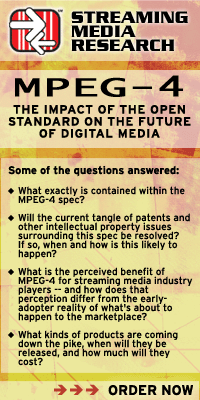 |
|
|
What a Metafile Is, and Why You Need Them By Michael
Long
"Metafile" is one of those words that seems to be all over streaming media these days. Don't worry, it's nothing to be alarmed by. A metafile is simply text containing information that describes or specifies another file. In the streaming industry, metafiles also describe files that tie sets of other files together. Examples of metafiles include the .ASX file from the Windows Media Platform, or .RAM and .SMI files from the Real Platform--but these are not the only metafiles around. When you hear experts refer to metafiles, they are usually talking about the files that glue streaming files together with events tied to the content. Windows Media Technologies uses the .ASX file to connect the web page to the streaming server. The web page refers to the metafile with a simple href link. < a href = "startshow.ASX" > The most important thing the .ASX files does is point to the streaming file (.ASF ) on the streaming server. Here is an example of a simple .ASX file. < .ASX VERSION=ŗ.0" > < ENTRY > < REF HREF="http://samples.microsoft.com/media.asf" > < /ENTRY > < /.ASX > If this looks like HTML, it is very close--it is actually XML. The .ASX file lives on the HTTP server with your web pages. It downloads to the clients machine when they click the href link and launches the Windows Media Player. This .ASX file above is very basic. You can add all kinds of information to the file including the author, title and copyright. You can stack ASF files together in a playlist or define actions to be taken at certain events. You can also add banners underneath the player. All of this is done through XML and is very easy to learn if you have experience with HTML. You edit metafiles the same way that you edit HTML documents. You can edit a metafile in any text editor and change the extension to that of the metafile (.ASX, .RAM or .SMI ). These metafiles live on the HTTP server right next to your web pages. Real Networks has an even more extensive metafile story. They started out with the .RAM file, which was very similar to the .ASX file. The .RAM file lived on the HTTP server containing a path to connect to the streaming server, and could contain a play list of .RM streams. A text editor (such as Notepad) can be used to create the metafiles--with following structure in place: pnm://www.yourserver.com/path/streamingfilename1 In the example above, 'www.yourserver.com' references the DNS name of the box serving your streams, 'path' points to the location of the file, and 'streamingfilename1' relates to the appropriate media file (i.e., .RM, .RA). If you want to create a list of Real files to play in succession when the user clicks the link, simply write a metafile containing multiple URLs on separate lines (leave no spaces between lines). pnm://www.yourserver.com/path/streamingfilename1 pnm://www.yourserver.com/path/streamingfilename2 pnm://www.yourserver.com/path/streamingfilename3 When clicked by a user, the files above will play automatically in the assigned order. Once you've written your metafile, save as "All files (*.*)" format, using the .RAM extension. Your next task is referencing the metafile within the HTML document. < a href= "http://www.webserver.com/path/streamingfilename1.ram" > Image Source or Text < /a > where 'streamingfilename1.ram' is the metafile. RealNetworks added interactivity through the creation of the .SMIL (Synchronized Multimedia Integration Language). SMIL code wrapped the streaming file into a static layout along with text files (.rt) and image files (.rp). Real glued all of this together within SMIL code. SMIL works in very much the same way that HTML does. It is a layout language for including several types of files together and is much more advanced than anything the Windows Media Group has to date.
|
| Copyright ©2002 Penton Media, Inc. All rights reserved. Privacy policy. |

